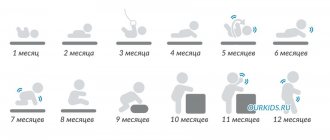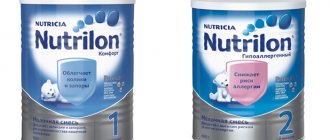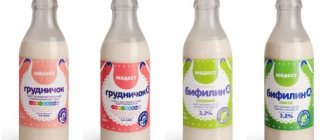Features of newborn immunity
Newborns' immune systems are stronger than previously thought. Despite the fact that after birth the body immediately has to fight viruses and bacteria, the baby grows and develops quickly. What does the immunity of a newborn baby depend on, how long does the immunity “borrowed” by the baby from the mother in utero life last, and how does the protection of breast milk and formula work during the period of growth and development of the baby, says neonatologist Valeria Maksimovna Shchelkunova.
— Valeria Maksimovna, what is immunity and do newborns have it?
— Immunity is the ability to withstand aggressive environmental influences. A child is affected by completely different factors: from pathogenic microorganisms and viruses to allergens. Environmental factors can also affect the infant’s immunity.
Previously, there was an opinion that a child is born with no immunity at all, since he is in a sterile environment for the entire nine months and there is no need for him to produce his own immune cells. Research in recent years has shown that the formation of a newborn’s immunity begins in utero.
What kind of immunity can a newborn baby have?
Innate immunity
| Acquired immunity
|
The formation of immunity in newborns occurs gradually. Their mothers help maintain the health of their babies - first in utero, then with breast milk, the mother passes on immune defense factors to the child. This happens until the baby’s immunity is fully formed and he is ready to independently confront the environment.
— What is the immunity of a newborn child and how does it differ from the immunity of an adult? How is immunity formed in those who have just been born?
— The immunity of a newborn differs even from the immunity of a five-year-old child. It is still immature and takes time to develop immune responses. First, the mother passes on antibodies to the baby for protection through the placenta and breast milk, and as soon as the baby is able to produce its own antibodies, the mother's ones stop working. An adult does not have such processes: in order to develop immunity to a disease, they need to get sick or be vaccinated.
Newborns also have critical periods - the most important for the formation of immunity. First of all, these are the first months of life. This is a real test for a child.
| 1st period - from birth to one month The child is protected by the mother's antibodies. There is an acquaintance with a huge number of environmental factors (a change in habitat means active contamination with microflora and pathogenic microorganisms). | Period 2 - three to four months The mother’s antibodies stop protecting the baby, the body undergoes a restructuring, and the child’s immunity has to cope with threats on its own. | 3rd period - adult child and age 18+ At an older age, there are critical periods, but after 3 years they are usually associated with a change in the usual living environment (kindergarten, school, etc.), exposure to external factors, and not a restructuring of the immune system. |
Child nutrition and immunity: in pursuit of the ideal
As an advertisement
Newborns and infants are exposed to a huge number of potentially pathogenic microorganisms. The immune system, which performs the function of protecting against infection, although it reaches a certain degree of development by the time the child is born, is still not mature enough and, therefore, is not able to function fully. The newborn’s body’s ability to resist infection is very limited, but this is compensated to a certain extent by passive immunity received from the mother.
Passive immunity is provided both by IgG, which performs the functions of antibodies, transmitted transplacentally from the mother to the fetus in the third trimester of pregnancy, and by IgA antibodies present in breast milk. In addition to IgA (including secretory IgA - sIgA), breast milk contains a large number of other nutrients that perform immune functions and support the baby’s immune system. Some protective factors in breast milk are too complex to be recreated in infant formula (IF). For example, IgA antibodies contained in breast milk cannot be reproduced in DMS. However, this turned out to be possible for other food components. This article examines the development of the immune system in newborns and infants, with particular emphasis on the role of the immune system in protecting against infections. In addition, the immunomodulatory role of various immunonutrients in breast milk and the possibilities of using these nutrients in the production of modern DMS are discussed.
The child's immune system and its development
The development of the immune system begins at the stage of embryogenesis, when the first hematopoietic cells appear outside the embryo, in the yolk sac. At the 6th week of gestation, hematopoietic stem cells develop in the fetal mesoderm, in the so-called aorta-gonadomesonephron [1]. Hematopoietic stem cells then migrate to the fetal liver and initiate erythropoiesis [2]. At 7 weeks of gestation, cells populate the developing thymus gland. Their colonization into the bone marrow occurs much later, at the 20th week of gestation [3].
In the thymus, T-lymphocytes undergo a number of changes, accompanied by the development of T-cell receptors. The development of killer cells and a variety of dendritic cells (DCs) also occurs in the thymus. B-lymphocytes, granulocytes, monocytes and DC are formed in the bone marrow. The development of lymphoid cells and organs is a complex process involving growth factors (cytokines and chemokines), receptors and adhesion molecules. At an early stage, the development of the immune system does not depend on antigenic stimulation.
By the time a child is born, a fundamental restructuring of the entire immune system occurs. Once born, the baby moves from a virtually sterile intrauterine environment into an external environment where many bacteria live. In the first days of life, the surfaces of the mucous membranes of the child’s digestive tract and respiratory tract are actively colonized by bacterial communities [4].
At birth, the lymphoid system remains immature, although it is relatively developed. At this stage, T and B lymphocytes are naive because they have not yet encountered antigens and do not carry immunological memory. It is possible that fetal T lymphocytes can encounter a number of antigens transplacentally, but this point of view remains controversial [5]. Activation of T lymphocytes leads to a response in which the production of Th2 cytokines (interleukins IL-4 and IL-5) dominates with relatively low production of the Th1 cytokine - interferon γ [6].
Like T lymphocytes, B lymphocytes are naïve and immature at birth, and memory B lymphocytes are not yet developed [7]. However, the newborn is able to mount an antibody response either against primary infection or upon primary vaccination with protein-containing vaccines. However, newborns are unable to respond to polysaccharide antigens, making them extremely susceptible to infections caused by polysaccharide-encapsulated bacteria, which include group B staphylococci and pneumococci. Polysaccharide-specific B lymphocytes at this age are already detected, but are not yet capable of expressing the CD21 coreceptor, which is necessary for the response to these antigens [8].
In the first days of a child's life, his gastrointestinal tract (GIT) and respiratory tract are colonized by microorganisms. The spectrum of commensal and pathogenic microorganisms and their corresponding pathogen-associated molecular patterns (PAMPs) is extremely broad. In principle, the immune system is capable of responding to almost any trigger. However, it has now been established that the immune system does not respond to any stimulus, but only to dangerous signals from the environment [9]. In this case, a mechanism is activated when PAMPs are recognized by a polymorphic set of receptors of the innate and acquired immune system [10], which determines the direction of development of the immune system both in childhood and in adults.
Infections at an early age
During pregnancy, the fetal immune system functions in collaboration with the mother's immune system. After birth, the newborn's immune system must switch to an independent track in order to protect the child from pathogens and be able to develop tolerance to harmless antigens, for example, food antigens.
The competence of the newborn's immune system progressively increases in the first months of life. The specific features of the newborn’s immune system determine the degree of susceptibility to certain infectious diseases.
First, T-cell immunity in a newborn is predominantly naive. Memory T cells in a healthy child develop gradually over the first years of life. T-cell responses to specific antigens are virtually absent at birth and in cord blood, except in cases of intrauterine infection. This means that every postnatal encounter with an infectious pathogen can lead to a primary infection. The immune system of a newborn is capable of fighting pathogenic microorganisms, but newborns and children in the first months of life suffer from viral infections to a greater extent than older children due to the reduced capabilities of T-cell immunity. Viruses such as respiratory syncytial virus, enteroviruses, and influenza viruses can cause severe illness. When encountering the same pathogen again, immunological memory is activated, which contributes to faster recovery and less morbidity.
Secondly, the production of antibodies in newborns and children in the first months of life is immature. As a result, these children are more prone to serious generalized infections. Pathogens found in the maternal birth canal, such as group B streptococci or intestinal microorganisms (E. coli), are the most common cause of bacterial infections in newborns. In young children, the production of antibodies to polysaccharide antigens, which is poorly developed, becomes a particular problem. For this reason, polysaccharide-encapsulated microorganisms, such as Streptococcus pneumoniae, are most often the causative agents of upper and lower respiratory tract infections and otitis media in infants. Immunization with conjugate vaccines using encapsulated bacteria (Haemophilus influenzae type B) and pneumococcal conjugate vaccine (PCV7) reduces the incidence of invasive disease in children. In general, infants are at risk for developing serious infections due to an immature immune system, and this requires vaccination against the most dangerous and common pathogens.
Allergy
The immune system is tightly controlled by its own regulatory system, which helps prevent inappropriate immune responses that can lead to pathological conditions. Errors in the functioning of this regulatory system underlie the occurrence of allergic or autoimmune reactions. Both genetic and environmental factors are involved in the body's susceptibility to autoimmune and allergic diseases.
Autoimmune diseases in children are relatively rare. Atopic diseases are much more common. The cumulative incidence of their development in childhood ranges from 20% to 30%. The pathogenesis of allergic diseases is multifactorial. In addition to a family history of allergies, which in itself makes a significant contribution to the risk of allergic diseases in a child, numerous polymorphic genetic markers are also related to this. In addition, environmental factors include the nature of nutrition and the composition of the diet, which influence the function of the digestive tract, the state of immune defense and exposure to food allergens [11].
Breastfeeding can have a preventive effect against allergic diseases. First of all, breastfeeding provides a protective effect against food allergies, since sensitization to allergens develops only when exposed to them. Cow's milk protein beta-lactoglobulin, which is the main allergen in cow's milk protein intolerance (CPI), is found in breast milk (HM), but in much smaller quantities than in cow's milk itself. In addition to reducing the impact of cow's milk proteins, GM affects the composition of the child's intestinal flora (with a predominance of bifidobacteria and lactobacilli) due to the high content of oligosaccharides in breast milk. On the contrary, a reduced content of bifidobacteria in a child’s stool at a very early age is associated with the development of allergic diseases later. However, if there is a lack or absence of GM, there is a need to use VHI. Feeding high-risk children and children with manifestations of food allergies with hydrolyzed formulas, especially highly hydrolyzed formulas, significantly reduces the incidence of allergy to CMP compared with standard milk formulas [12].
The role of breast milk in the immunological protection of the child
As already mentioned, the immaturity of the child’s immune system is compensated for by passive immunity transmitted from the mother to the newborn. This passive immunity is provided both by maternal immunoglobulins and by protective factors in breast milk.
In the third trimester of pregnancy, active transport of maternal IgG occurs through the placenta. As a result, during full-term pregnancy, the level of IgG in the newborn is close to that of the mother. Let us remember that IgM and IgA antibodies are not able to be transported across the placenta. The half-life of maternal IgG antibodies is 21 days, so they completely disappear by 3 months of age. Longer-term support of passive immunity is provided through breastfeeding.
Globally, the role of breastfeeding is extremely important. There is evidence that optimal breastfeeding (which refers to exclusive breastfeeding for up to 6 months and continued breastfeeding for up to 1 year) can prevent the deaths of 1.3 million children annually [13].
GM contains 0.4–1.0 g/l of secretory IgA, the protective properties of which are directed against intestinal and respiratory pathogenic microorganisms in the immediate environment of the mother and child. In addition, GM contains numerous components that directly or indirectly help protect the child’s body from infection.
Lactoferrin and lysozyme are proteins with direct antibacterial activity. Lactoferrin is an iron-containing and iron-binding glycoprotein that inhibits the growth of pathogenic microorganisms by blocking iron from bacterial cells. The terminal aminopeptide of lactoferrin, lactoferricin, has independent bactericidal activity. Since lactoferrin is resistant to proteolytic enzymes, the bulk of lactoferrin obtained in breast milk is retained during passage through the baby’s digestive tract.
Lysozyme is an antimicrobial peptide that breaks down peptidoglycans in the cell wall of bacteria. It is present in breast milk at a concentration 300 times higher than that in cow's milk.
In one serving of expressed milk, about 130 different oligosaccharides can be determined. Many of them function as receptor analogues (false receptors) and are able to inhibit the binding of bacterial or viral pathogens and toxins to intestinal epithelial cells. The structure of oligosaccharides is determined by the specificity of binding to adherent receptors of bacteria or bacterial toxins. For example, GM1 gangliosides are analogues of receptors for toxins produced by V. cholerae and E. coli, while lacto-N-fucopentaose prevents the transfer of human immunodeficiency virus 1. It has been established that certain glycosylated proteins (mucins) prevent the fixation of bacteria and viruses to the intestinal wall . Lactadherin, a component of milk fat globules, has a protective effect against rotavirus infection [14]. Free fatty acids and monoglycerides formed during the enzymatic breakdown of triglycerides can interrupt viral replication [14].
Oligosaccharides also promote the proliferation of beneficial bifidobacteria and lactobacilli in the gastrointestinal tract. These microorganisms, which are defined by the term “probiotics,” have a positive effect on the health of children and adults, since they produce organic acids that inhibit the growth of opportunistic microorganisms.
It can be added that the GM contains leukocytes, including neutrophils (40–65% of total leukocytes), monocytes/macrophages (35–55%) and activated CD8+ T lymphocytes (5–10%). It is not yet clear whether these cells are able to transfer functional cellular immunity from mother to child during breastfeeding.
The GM contains a variety of cytokines and chemokines: pro-inflammatory cytokines - IL-1, tumor necrosis factor alpha (TNF-α), Th-1 cytokines - interferon gamma and IL-2, Th-2 cytokines IL-4, IL-5 and IL-13, regulatory cytokines IL-10 and transforming growth factor-beta (TGF-β), as well as chemokines IL-8 and CCL-5. Granulocyte-macrophage colony-stimulating factor (GM-CSF), erythropoietin, and cortisol are also found in GM.
In addition to the above components, which have a direct effect on the immune system, GM also contains a number of other ingredients that indirectly affect the child’s immune system, including vitamins, minerals and nucleotides.
Taking into account the above, GM should be regarded as an irreplaceable immunological source that helps maintain passive and active immunity in the most vulnerable age of a child, which is the first months and first year of life [14]. Many of these components are completely essential, for example, secretory IgA. However, there are also reproducible components that can be included in modern voluntary medical insurance.
The contribution of infant formula to the formation of immunity
Since the newborn's immune system is immature, malnutrition and protein-energy malnutrition can significantly impede its development [15]. Deficiency of important micronutrients and starvation lead to disruption of the development and differentiation of the normal immune system. The combination of chronic malnutrition and infectious diseases further weakens the immune response. Micronutrient deficiency impairs the production of antibodies and inhibits the cellular immune response, also negatively affecting the parameters of innate immunity [16]. Combined micronutrient deficiencies exacerbate the negative effects on various components of the immune system. For this reason, if children are deficient in one or more micronutrients, immune system function is inevitably impaired.
Long chain polyunsaturated fatty acids
Long-chain polyunsaturated fatty acids (LCPUFAs) were initially added to infant formula to improve growth performance and have a positive effect on visual acuity and neuropsychological development [17]. In breast milk, the main representatives of LCPUFAs are docosahexaenoic acid (DHA, C22:6 omega-3) and arachidonic acid (AA, C20:4 omega-6). Omega-3 and omega-6 LCPUFAs are metabolic competitors and have varying effects on eicosanoid metabolism, cell membrane function, and the immune system. Eicosapentaenoic acid (EPA, C20:5 omega-3), the content of which is low in breast milk and body tissues, is a direct metabolic competitor of AA.
In vitro studies and laboratory experiments have shown that DHA and AA affect the immune system in different ways. PUFAs influence T cell function by increasing or decreasing the production of eicosanoids from AA. The production of these mediators is reduced under the influence of omega-3 LCPUFAs [18]. In addition, EPA is a substrate for cyclooxygenase and lipoxygenase, enzymes that disrupt the structure of eicosanoids and reduce their biological potential. New families of EPA-derived eicosanoid-like mediators, called E- and D-resolvins, have anti-inflammatory and anti-inflammatory properties in tissue culture and in animal experiments [19].
In addition, polyunsaturated fatty acids (PUFAs) can disrupt gene expression by altering transcription factor activity and through the incorporation of omega-3 LCPUFAs into the phospholipid membrane with subsequent changes in membrane structure and function. Omega-3 LCPUFAs are potential anti-inflammatory agents and can be used therapeutically for acute and chronic inflammatory diseases [48]. From another point of view, it is believed that increased consumption of omega-6 PUFAs underlies the current increase in the incidence of bronchial asthma and other allergic diseases [20]. The relationship between these two diseases (asthma and atopic dermatitis) with the consumption of omega-3 and omega-6 PUFAs is complex and has different mechanisms. In atopic dermatitis, there is a deficiency of certain enzymes, which leads to disruption of PUFA metabolism and is expressed in disruption of the structure and function of epithelial cells [21].
There is relatively little data on the effect of enriching children's diets with PUFAs on the child's immune system. In one study of premature infants, fortification of infant formula with LCPUFA promoted changes in lymphocyte population, phospholipid composition, and cytokine production in the same direction as was typical for GM-fed infants [22].
Currently, a group of experts from the European Society for Pediatric Gastroenterology, Hepatology and Nutrition (ESPGHAN) notes that if LCPUFAs are added to infant formula, then omega-6 and omega-3 acids should be in a balanced ratio [23]. Modern infant milk formulas Frisolak 1 and 2 Gold produced by the Dutch company FrieslandCampina contain both essential PUFAs and LCPUFAs of the omega-6 and omega-3 families in optimal quantities and ratios in accordance with the current requirements and recommendations for the composition of VHI.
Prebiotics
It is well known that intestinal flora plays an important role in the postnatal development of the immune system. The lower incidence of intestinal infections in breastfed children is explained by the more favorable composition of the intestinal microflora. Bifidobacteria and lactobacilli that colonize the colon inhibit the growth of pathogenic microorganisms through the production of lactic, acetic and other organic acids, which leads to a decrease in pH in the intestinal lumen. This more acidic environment inhibits the growth of pathogenic microorganisms. On the contrary, when feeding with regular DMS, the pH in the intestinal lumen is close to neutral due to the predominant flora.
Bifidobacteria and lactobacilli compete with potentially pathogenic microorganisms for nutrient substrates and for adhesion to intestinal epithelial cells. A large number of facts have accumulated indicating the modulating role of intestinal microflora in mucosal physiology, intestinal barrier function, and in the formation of a systemic immune response [24, 25].
There are two different (but not mutually exclusive, but complementary) approaches in terms of influencing the composition and balance of intestinal microflora. The first approach is to use live lactic acid bacteria and bifidobacteria (probiotics), the second is to use oligosaccharides that are not broken down by enzymes of the small intestine and are actively used by the colon microflora for life (prebiotics).
GM contains a wide range of different oligosaccharides that have prebiotic activity and therefore have an effect on the composition of the intestinal microflora. Since GM oligosaccharides are not only diverse, but also complex in structure and polymorphic, it is currently not possible to add oligosaccharides in exactly the same composition as in GM to DMS. As an alternative, it has been proposed to add to DMS either only galactooligosaccharides (GOS), as in breast milk (World Health Organization, Codex Stan 72–1981, 2007), or a combination of GOS and fructooligosaccharides (FOS) (EU Directives 2006) [26, 27] . The Frisolak 1 and 2 Gold products contain GOS in physiologically justified amounts of 0.25 g/100 ml and 0.4 g/100 ml, which contributes to the formation of normal intestinal microflora in a child and does not cause side effects [28].
Accumulating results indicate that the addition of oligosaccharides to DMS induces the composition and metabolic activity of intestinal microflora closely resembling those of breastfed infants [29].
The bifidogenic effect of oligosaccharides has been proven quite convincingly, but there is much less data on their effect on the immune system. There is evidence that prebiotics improve the production of antibodies after vaccination and also help reduce the incidence of atopic dermatitis [30]. It is likely that these properties of oligosaccharides have not yet been fully studied and require further research.
Nucleotides
In breast milk, nucleotides (NT) are present in the form of nucleic acids, nucleosides and nucleotides themselves [31, 32]. For children in the first year of life, exogenous intake of NT is of great importance to facilitate the synthesis of nucleic acids. This is primarily important for premature infants, since they are characterized not only by a limited ability to synthesize NA, but also by limited opportunities for feeding GM. In addition to precursors for nucleic acid synthesis, NTs also act as intercellular and intracellular biological mediators. Currently, DMS enriched with NTs are produced all over the world. Thanks to the addition of NT to milk formulas, a positive effect on the indicators of humoral and cellular immunity of children is achieved, and the risk of a number of diseases is reduced and their prognosis is improved [33, 34].
There are several randomized studies involving both full-term and premature newborns, which showed improved antibody formation after vaccination, as well as faster maturation of lymphocytes when adding NT to DMS [35]. The most effective is additional administration of NT to children at risk - premature babies and children from socially disadvantaged families. A number of studies have shown that NT help reduce the risk of intestinal infections [36]. The levels of enrichment with DMS nucleotides differ from their natural content in breast milk and are strictly regulated by international and Russian documents. Only 5 main nucleotides (cytidine monophosphate, adenosine monophosphate, uridine monophosphate, inosine monophosphate, guanosine monophosphate) out of 13 contained in GM are standardized. EU directives allow up to 5 mg/100 ml of the mixture, and domestic standards allow up to 3.5 mg/100 ml of the mixture. It is important for DMS manufacturers to maintain an effective fortification level that has been clinically proven, as in Frisolac 1 and 2 Gold mixtures (where fortification levels meet the average European recommendations of 3.2–3.3 mg/100 ml) [37].
So, let's summarize some results. The first principle that underlies the development of modern VHI is the well-known thesis that GM is the “gold standard” in baby nutrition. However, the actual levels of various immunomodulatory components in breast milk can be difficult to extrapolate to the composition of DMS. These components should not so much quantitatively replicate the composition of GM, but rather reproduce the physiological effect that is provided by GM.
The second most important principle is safety and nutritional adequacy, that is, compliance with the normal nutritional needs of the child. Immature organs and systems should not be subjected to excessive stress. Therefore, VHIs must contain ingredients in quantities that meet the nutritional needs of the child and have any positive physiological effect [38, 39].
Considering the immaturity of the child’s immune system, the imperfection of the immune status, as well as the fact that this has a long-term impact on the subsequent development of the child, it is extremely important to optimize the composition of VHI in such a way as to ensure the maximum possible parameters of immunomodulation and a positive effect on the state of the immune system. Not only in the first 6 months of life, but also in older age, it is important to maintain the immune system in a state of effective protection against infection. In order to successfully grow and develop in a world populated by a huge number of microorganisms, the child’s body needs an adequately functioning immune system. This is facilitated by successful breastfeeding, and if this is not possible, modern infant formula enriched with specific ingredients that help maintain the child’s immune system.
Literature
- Le Douarin NM The Claude Bernard lecture, 1987. Embryonic chimeras: a tool for studying the development of the nervous and immune systems // Proc R Soc Lond B Biol Sci. 1988; 235:1–17.
- Marshall CJ, Thrasher AJ The embryonic origins of human haematopoiesis // Br J Haematol. 2001; 112:838–850.
- Plum J., De Smedt M., Verhasselt B. et al. Human T lymphopoiesis. In vitro and in vivo study models // Ann NY Acad Sci. 2000; 917:724–731.
- Favier CF, Vaughan EE, de Vos WM, Akkermans ADL Molecular monitoring of succession of bacterial communities in human neonates // Appl Environm Microbiol. 2002; 68:219–226.
- Prescott SL, Macaubas C, Holt BJ et al. Transplacental priming of the human immune system to environmental allergens: universal skewing of initial T cell responses toward the Th2 cytokine profile // J Immunol. 1998; 160:4730–4737.
- Liew FY Th1 and Th2 cells: a historical perspective // Nature Rev Immunol. 2002; 2:55–60.
- Agematsu K., Nagumo H., Yang F.C. et al. B cell subpopulations separated by CD27 and crucial collaboration of CD27. B cells and helper T cells in immunoglobulin production // Eur J Immunol. 1997; 27:2073–2079.
- Peset LM, Harms G., Hardonk MJ, Timens W. Human immune response to pneumococcal polysaccharides: complement-mediated localization preferentially on CD21-positive splenic marginal zone B cells and follicular dendritic cells // J Allergy Clin Immunol. 1996; 97:1015–1024.
- Matzinger P. The danger model: a renewed sense of self // Science. 2002; 296:301–305.
- Medzhitov R. Toll-like receptors and innate immunity // Nature Rev Immunol. 2001; 1: 135–145.
- Upham JW, Holt PG Environment and development of atopy // Curr Opin Allergy Clin Immunol. 2005; 5: 167–172.
- Friedman NJ, Zeiger RS The role of breast-feeding in the development of allergies and asthma // J Allergy Clin Immunol. 2005; 115:1238–1248.
- Jones G., Steketee RW, Black RE, Bhutta ZA, Morris SS; Bellagio Child Survival Study Group. How many child deaths can we prevent this year? // Lancet. 2003; 362:65–71.
- Labbok MH, Clark D., Goldman AS Breastfeeding: maintaining an irreplaceable immunological resource // Nat Rev Immunol. 2004; 4:565–572.
- Woodward B. The effect of protein-energy malnutrition on immune competence. In: Suskind RM. Nutrition, immunity and infection in infants and children. Philadelphia, Vevey/Lippincott Williams and Wilkins, 2001, 89–120.
- Cunningham-Rundles S., McNeeley DF, Moon A. Mechanisms of nutrient modulation of the immune response // J Allergy Clin Immunol. 2005; 115:1119–1128.
- Borovik T. E., Gribakin S. G., Zvonkova N. G., Skvortsova V. A., Stepanova T. N., Shmakova S. G. Nutrition and brain development: the role of long-chain polyunsaturated fatty acids // Pediatrics. 2012, no. 2, 67–73.
- Calder PC N-3 polyunsaturated fatty acids, inflammation, and inflammatory diseases // Am J Clin Nutr. 2006; 83(suppl 6):S1505–S1519.
- Serhan CN Novel eicosanoid and docosanoid mediators: resolvins, docosatrienes, and neuroprotrectins // Curr Opin Clin Nutr Metab Care. 2005; 8: 115–121.
- Devereux G. The increase in the prevalence of asthma and allergy: food for thought // Nat Rev Immunol. 2006; 6:869–874.
- Devereux G., Seaton A. Diet as a risk factor for atopy and asthma // J Allergy Clin Immunol. 2005; 115:1109–1117.
- Field CJ, Thomson CA, Van Aerde JE, Parrott A., Euler A., Lien E., Clandinin MT Lower proportion of CD45 R0. cells and deficient interleukin-10 production by formula-fed infants, compared with humanfed, is corrected with supplementation of long-chain polyunsaturated fatty acids // J Pediatr Gastroenterol Nutr. 2000; 31: 291–299.
- Koletzko B., Baker S., Cleghorn G. et al. Global standard for the composition of infant formula: recommendations of an ESPGHAN coordinated international expert group // J Pediatr Gastroenterol Nutr. 2005; 41:584–599.
- Gribakin S.G. Prebiotics versus probiotics? // Question det. Dietetologiya, 2003, No. 1, 71–74.
- Agostoni C., Axelsson I., Goulet O. et al. ESPGHAN Committee on Nutrition. Prebiotic oligosaccharides in dietetic products for infants: a commentary by the ESPGHAN Committee on Nutrition // J Pediatr Gastroenterol Nutr. 2004; 39: 465–473.
- Kunz C., Rudloff S., Baier W., Klein N., Strobel S. Oligosaccharides in human milk: structural, functional, and metabolic aspects // Annu Rev Nutr. 2000; 20: 699–722.
- Boehm G., Jelinek J., Stahl B. et al. Prebiotics in infant formulas // J Clin Gastroenterol. 2004 (suppl 6); 38:S76–S79.
- Ben Xiao Ming, Zhu Xiao Y, Zhao Wei, Yu Wen Ling, et al. The influence of milk formula enriched with galacto-oligosaccharides on intestinal microflora and fermentation in full-term infants // Issues. modern pediatrics. 2005, no. 5, 3–6.
- Fanaro S., Boehm G., Garssen J. et al. Galactooligosaccharides and long-chain fructo-oligosaccharides as prebiotics in infant formulas: a review // Acta Paediatr Suppl. 2005; 94:22–26.
- Knol J., Scholtens P., Kafka C. et al. Colon microflora in infants fed formula with galacto-and fructooligosaccharides: more like breast-fed infants // J Pediatr Gastroenterol Nutr. 2005; 40: 36–42.
- Gribakin S. G., Kazakova S. N., Andreeva A. V. The importance of nucleotides in the nutrition of infants // Issues. pract. pediatrics. 2006, vol. 1, no. 1, p. 70–74.
- Maldonado J., Navarro J., Narbona E., Gil A. The influence of dietary nucleotides on humoral and cell immunity in the neonate and lactating infant // Early Hum Dev. 2001; 65 (suppl): S69–S74.
- Schaller JP, Kuchan MJ, Thomas DL et al. Effect of dietary ribonucleotides on infant immune status. Part 1: Humoral responses // Pediatr Res. 2004; 56:883–890.
- Buck RH, Thomas DL, Winship TR et al. Effect of dietary ribonucleotides on infant immune status. Part 2: Immune cell development // Pediatr Res. 2004; 56:891–900.
- Hawkes JS, Gibson RA, Roberton D., Makrides M. Effect of dietary nucleotide supplementation on growth and immune function in term infants: a randomized controlled trial // Eur J Clin Nutr. 2006; 60: 254–264.
- Yau KI, Huang CB, Chen W. et al. Effect of nucleotides on diarrhea and immune responses in healthy term infants in Taiwan // J Pediatr Gastroenterol Nutr. 2003; 36: 37–43.
- Korovina N. A., Zakharova I. N., Lykina E. V. The influence of nucleotides on the formation of local intestinal immunity in children // Issues. modern pediatrics. 2007, no. 4, 23–28.
- Gribakin S.G. Ways of biological adaptation of human milk substitutes // Issues. pract. pediatrics. 2008, No. 2, p. 39–45.
- Garankina T.I., Gamaleeva A.V., Gribakin S.G. The role of immunonutrients in infant formula // Vopr. det. Dietetics 2009, no. 4, 20–25.
S. G. Gribakin1, Doctor of Medical Sciences, Professor O. A. Bokovskaya A. A. Davydovskaya
Anika RU LLC, Moscow
1 Contact information
Weak immunity, what to do?
It would be a good idea to consult a pediatric immunologist. In any case, parents need to adjust the baby’s diet, feed him varied and healthy, giving preference to natural products. You cannot force a child to eat. If possible, replace pharmacy vitamins with seasonal berries, fruits, and vegetables. Synthetic vitamins often cause allergies. Instead of store-bought sweets and chips, feed your child milk porridge, natural meat, and fish. It is necessary to instill in your child the habit of proper nutrition, and not of harmful fast food. Healthy food and fresh air are the foundation on which a child's health is built.
Modern children have a huge advantage over children of past times in that they are routinely vaccinated against infectious diseases, since even the very strong immunity of our ancestors often could not withstand terrible epidemics. Do not believe doctors who advocate a childhood without vaccinations. A good pediatrician will use every opportunity to carry them out, even if the child suffers from chronic illnesses. Vaccinations make it possible to emerge from battles with diseases with minimal losses.
How does complementary feeding affect a child's immunity?
18.03.2021
Breast milk, as well as adapted dry formulas, contains a large number of useful substances that a child needs at a certain age. It is the composition of formula or breast milk that allows for the immunological protection of the child, but only up to a certain age. Upon reaching the age of five months, the vitamins and minerals contained in breast milk become insufficient for the normal functioning of the body and the development of the child. That is why gradual complementary feeding is introduced into the child’s diet in the form of food that contains the necessary substances and, most importantly, is able to be absorbed by the child’s body.
How does breast milk affect a baby's immune system?
immune system begins its development in the womb. Moreover, the features of the immune system , which can manifest themselves before reaching the first year of life, depend on many factors that begin their action from the first day of conception.
From birth, a child is exposed to a large number of microbes that are not visible to the naked eye, but are present in the atmosphere. They are safe for an adult, but pose a danger to a newborn child who has just been born.
From the first days of life, breast milk helps to cope with all external factors, which contains elements necessary for the child’s body that help strengthen his immunity . It is thanks to the composition of breast milk that the child’s body quickly strengthens and ceases to be susceptible to microorganisms from the outside.
Previously, it was believed that children growing up on dry formulas for some reason were more vulnerable to external irritants, but in fact, modern formulas contain all the necessary substances that also help develop the immunity .
Even after a child reaches the age of one year, breast milk is very beneficial for him, despite the fact that children of this age have already been introduced to complementary foods that also contain the necessary substances. It is believed that breast milk helps strengthen the immune system , so experts say that continuing to drink breast milk for a child after a year is very beneficial.
How does artificial feeding affect a child's immunity?
Despite the fact that modern infant formulas contain the necessary vitamins and substances for the normal development of a child, the first contact of a newborn with colostrum is very important.
It has been proven that in the first days of a child's life, when the newborn is still very vulnerable, he should receive at least a small portion of colostrum or breast milk, even if he is subsequently transferred to artificial feeding. A small dose of colostrum or milk plays a huge role in the formation immunity in the first days of life.
In the first weeks and months of life, thanks to breast milk, the child develops the correct functioning of the gastrointestinal tract, all body processes are launched, and the immune system .
Those children who, for some reason, have never received breast milk, and are bottle-fed from the first days of life, are more susceptible to allergies, as well as to various infections, since their immune system was not launched in the correct way and strengthened with with the help of necessary substances.
Despite this, it is necessary to note the fact that modern formulas for feeding from the first days of life are adapted and as close in composition to natural milk as possible. That is why currently breastfed children have higher immunity and are less susceptible to the development of infectious diseases, compared to children who were fed with conventional dry formula several decades ago.
Published in Immunology Premium Clinic
Immunity of breastfed and bottle-fed infants
Newborns have immunity, but it develops gradually and depends on many factors. How does the “protection” of a newborn baby work, what components of breastfeeding and artificial feeding make the immune system stronger? We are looking into this difficult topic with pediatrician Ekaterina Borisovna Bulavina.
— Ekaterina Borisovna, what features of immunity do doctors note in children during the newborn period?
— There is an opinion that a newborn child is almost completely devoid of immunity and is not able to cope with infections on his own. In reality this is not the case. Normally, a healthy newborn child has a special state of the immune system, thanks to which it is able to withstand aggressive environmental factors.
The first four weeks of life are the first critical period for the development of the immune system, when the child's sensitivity to viral infections is high.
— How is immunity formed in a child during full-term pregnancy?
— Despite their apparent defenselessness, children in their first year of life rarely get sick and, as a rule, not seriously. This is due to the fact that all babies are born with a fully developed innate immune system and temporary immunity in the form of maternal antibodies transferred transplantally. Antibodies can circulate in the blood for three to six months and are gradually destroyed by the time the baby can produce them on his own.
Each new encounter with an infectious agent trains the acquired immune system, teaching special cells to recognize foreign agents and produce specific protective antibodies. The peak of such training occurs when children start attending kindergarten. It is at this time that children get sick most often.
Early acquaintance of the body with different antigens forms high-quality and properly functioning immunity of the infant, which reduces the risks of developing allergic and autoimmune reactions. On the contrary, the sterile conditions that parents try to create greatly harm the health of children and deprive their immune systems of important and timely training.
Immunity in infants on different diets
— Breastfeeding is an important, although not the main component of protecting a young child from infections.
Breast milk and baby's immunity
| Immunoglobulins, ready-made antibodies class A and G |
|
| Nonspecific protection factors |
|
| Other Ingredients |
|
Infant formula and child immunity
— If children are deprived of the opportunity to receive mother's milk, this does not mean that they remain defenseless against infectious agents. Modern milk formulas, created based on the results of studies of the composition of human milk, are able to support the protective functions and immunity of bottle-fed children.
Experimental and clinical studies have proven that there are a number of nutrients that influence the immune status and the course of inflammatory processes in children.
| Prebiotics (eg GOS) | GOS roles:
|
| Nucleotides | Promotes adequate maturation of the immune system in children of the first year of life. |
| Other food elements | Iron, zinc, selenium, vitamins A, C, E, D3, probiotics and other microelements and substances have a diverse effect on all parts of the innate and acquired immunity. |
— The similarity of infant formula with breast milk does not reduce the number of parents who are skeptical about the beneficial effects of formula on the immune system. Does the immunity of breastfed and bottle-fed children differ? What to believe and what not to believe?
— Breast milk undoubtedly provides a unique set of biologically active components that help maintain the child’s passive and active immune system. But among these components there are both absolutely irreplaceable ones, for example, secretory immunoglobulin A, and those that were replicated in the laboratory and included in milk formulas. The determining factor in the formation of an adequate immune response in a formula-fed baby will be the timely intake of the necessary microelements and nutrients into the body with an adapted milk formula.
Myths about the negative impact of infant formula on the immune system appeared a long time ago, when the composition of the formula only vaguely resembled breast milk, and their use often negatively affected the health of babies. Artificial feeding with modern adapted formulas is a fairly complete nutritional alternative if breastfeeding is impossible.
Correctly selected infant formula does not have negative consequences for the child’s health. Modern formulas are developed on the basis of more and more new research, and manufacturers have the opportunity to bring the qualitative and quantitative composition of breast milk as close as possible.
— How is immunity formed in premature babies?
— The formation of cellular and humoral immunity in children directly depends on the degree of prematurity and the severity of intrauterine malnutrition. Protective antibodies enter the baby’s body in the third trimester of pregnancy, so the shorter the gestational age, the fewer antibodies the baby manages to receive from the mother.
Prematurely born babies have a syndrome of immune system maladjustment:
- pronounced imbalance between immunoregulatory cells;
- transient T-cell deficiency;
- insufficiency of the phagocytic link;
- low concentration of serum immunoglobulin G.
In addition, an increased level of immunoglobulin E in very premature newborns at the end of the first month of life indicates their predisposition to the development of diseases, which must be taken into account when preparing the diet of a nursing mother or when choosing an adapted milk formula, as well as prescribing medications and vaccinations.
Transient immunological deficiency of premature infants is one of the main reasons for their high susceptibility to infectious and inflammatory diseases caused not only by pathogenic, but also by opportunistic flora.
— At what age does an infant develop immunity that is independent of maternal protection?
— The statement that the baby’s immunity completely depends on the mother is only partly true. Of course, passive immunity is important for a baby, but one should not write off one’s own innate immunity and nonspecific protective factors. They can also quite successfully resist the invasion of pathogens by responding with an increase in body temperature and a local inflammatory response.
| Maternal antibodies disappear completely by 6 months. At this point, the child’s body is already able to produce a small amount of antibodies, which is also facilitated by primary vaccination and revaccination vaccinations. | The peak load on the immune system is the beginning of kindergarten at 2-3 years old. With the expansion of contacts comes acquaintance with a large number of viral and bacterial pathogens. But local immunity remains immature, so the child is still sensitive to infections. |
— Is immunocorrection carried out in children under one year of age?
— Immunity up to one year of age relies to a greater extent on maternal antibodies and protective factors of breast milk. A healthy full-term baby on breastfeeding does not need immunocorrection. Proper care and rational feeding are enough.
Premature babies and children receiving formula are at risk and require more careful monitoring and selection of immunocorrection methods. In the absence of serious health problems, severe pathology of the central nervous system, or congenital defects of the immune system, adherence to a rational daily regimen, hardening, and a properly selected mixture is usually sufficient as immunocorrection. In other cases, a consultation with an immunologist is required for a more in-depth examination and specific treatment.
— How can you boost your child’s immunity? What vitamins are best for children to take for immunity?
— In an infant, nonspecific and medicinal methods of strengthening the immune system can be used.
How to restore a child's immunity
Nonspecific correction methods:
| Drug methods of immunocorrection:
| Vitamin therapy:
|
— The child receives all essential vitamins and microelements through mother’s milk or formula. The diet of a nursing mother should be complete and varied.
— What should you pay attention to when choosing an infant formula that strengthens the immune system?
— The choice of breast milk substitute should be approached very responsibly. And it is better if the initial mixture is prescribed by a pediatrician, taking into account the baby’s health condition.
Main selection factors
- Anthropometric indicators, their correspondence to calendar age.
- The mother has complaints.
- Signs of allergies.
- Family history data.
Which formula is best for newborns and infants?
| Formulas for healthy children |
|
| Formulas for premature babies |
|
| Allergy mixtures |
|
| Other specialized medicinal mixtures |
|
— When choosing a mixture, you should pay attention to its composition and the presence of such ingredients as:
- polyunsaturated fatty acids Omega-3 and Omega-6 in the correct ratio;
- nucleotides, which are important in the formation of a healthy immune response;
- pre- and probiotics, which help in the colonization of the gastrointestinal tract with beneficial microflora.
Baby formula should not contain components that can cause allergic reactions: preservatives, flavorings, taste enhancers.
— Can frequent changes of formula affect the child’s immunity?
— Any food other than breast milk is foreign to the baby, and his body must adapt to the new. You can evaluate whether the mixture is suitable or not earlier than after three weeks of its use, and if problems arise, you should consult a doctor and not change brands of food yourself. Perhaps the doctor will select a mixture for another purpose: therapeutic, hypoallergenic, prophylactic.
With frequent changes of formula, the risk of developing allergies increases, digestive problems appear, and the process of formation of intestinal microbiocenosis is disrupted, which directly affects the baby’s immunity. Allergic inflammation of the skin and mucous membranes reduces their protective barrier function, and the risk of colonization by pathogens increases. Therefore, a series of mixtures causes health problems, in particular with immunity.
A newborn baby, despite its apparent defenselessness, is quite good at resisting infections. In this it is helped by the innate nonspecific defense system, maternal antibodies, protective factors of breast milk or adapted formulas. Advances in nutritional science make it possible to create formulas that are as close in composition as possible to the composition of breast milk. Mother's milk nutrients such as oligosaccharides, polyunsaturated fatty acids, and nucleotides have been reproduced and included in formulas. The emergence of such highly adapted mixtures has made it possible to reduce the gap in the development of immunity in breastfed and bottle-fed babies.
Pediatrician 1st category
Bulavina Ekaterina Borisovna
*The ideal food for an infant is mother's milk. WHO recommends exclusive breastfeeding for the first 6 months. MAMAKO® supports this recommendation. Before introducing new foods into your baby’s diet, consult a specialist.
Was this article helpful? Share it on social networks!
Colostrum feeding period
The stage of colostrum feeding is extremely important from the point of view of developing the child's immunity . Colostrum received by the baby in the first hours after birth is a means of immunization. It contains more antibodies and blood cells than mature milk. It is colostrum that gives the newborn the first defense against most viruses and bacteria that he will encounter. The level of protective factors in colostrum is so high that it is considered not so much as a food product, as a healing agent. This is the first “vaccination” that tones the baby’s immune system . Immune factors in colostrum play an important role in preparing the child’s digestive system for the feeding process. They cover the immature surface of the intestine with a protective layer, protecting it from bacteria, viruses, parasites and other pathogenic factors. If colostrum and breastfeeding are organized correctly in the first minutes of a child’s life, he will receive immunization, which allows him to maintain health during the first years of life. Even if the mother managed to establish full breastfeeding not immediately after the birth of the child, her baby receives a smaller, but still sufficient share of immune protection.
Let's go to kindergarten
During this period, contacts with friends, and as a result, the exchange of his flora becomes maximum. The immune system is constantly in a fight, which is very good for it. At this moment illnesses begin.
Some parents believe that if their child gets sick more than 8-10 times a year, he has poor immunity and needs to be examined for immunodeficiency. According to many pediatricians, there are no morbidity standards. Since children's immunity is immature, they become familiar with many pathogens in the garden and learn to produce specific antibodies to them.
Of course, during this period a lot depends on the kindergarten teachers. Wet cleaning during the day, regular ventilation, and humidification of the air - these actions help reduce the spread of infections. The child’s body receives less viral load and can cope with it without complications.
Clinical effectiveness of Bifidum BAG and Trilact:
Biological products Bifidum BAG and Trilact have: antiviral, antibacterial and antifungal effects; stimulate the formation of protective mechanisms in the child’s body;
Bifidum BAG - containing active bifidobacteria - is the optimal remedy for the correction of microflora disorders and the targeted formation of immunity and microflora in newborns (full-term and premature).
Liquid probiotic Trilact - contains active lactobacilli that successfully suppress the growth of various pathogens and reduce allergenicity in the body
- — the immunity and microflora of the newborn are improved and properly formed;
- — intrauterine infection of the newborn (enterocolitis) is prevented;
- — the newborn’s body’s resistance to nosocomial infections (staphylococcus, klebsiella, etc.) increases, the frequency of diseases decreases, and allergies are eliminated;
- —the percentage of purulent-septic complications in the maternity hospital is reduced by 2 times;
- —immunity is activated 1.5 times;
- - the coefficient of allergic mood of the body decreases by 65%;
- - the incidence of ARVI and influenza is reduced by 5 times;
- — the general condition of all newborns improves: intestinal functions, appetite, stable weight gain appears;
Effectiveness of probiotics
Data from Japanese researchers prove the benefit of very early use of bifidobacteria in low birth weight newborns to begin colonization of bifidobacteria and the formation of intestinal flora.
In the group of newborns who received a bifidoprobiotic in the first hours of birth, the full formation of the flora began within 2 weeks.
In the same children who received a probiotic one day after birth, the formation of flora was formed within 4 weeks (a day late with the probiotic resulted in a delay in the formation of flora by a month). In the group of children who did not receive probiotics and after 7 weeks
the formation of flora was not observed, bifid flora was absent.











